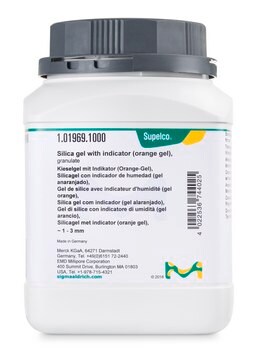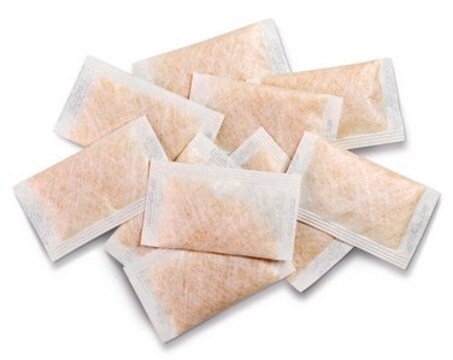94098
Drying pearls orange
Synonyme(s) :
Aluminum silicate, Silica gel orange
Se connecterpour consulter vos tarifs contractuels et ceux de votre entreprise/organisme
About This Item
Produits recommandés
Description
heavy metal free
Niveau de qualité
Forme
beads
Capacité
>30 % absorption capacity (water)(at 80% rel. humidity, 25°C)
Description générale
Drying pearls Orange (Silica gel orange), commonly used as a drying agent in laboratories, is suitable for drying all gases and solids. It is used in desiccators, drying towers, and absorption tubes. Silica gel orange provides longer storage conditions due to its large surface area which enables high absorption capacity. It also changes its color from orange to colorless after moisture absorption (approx. 6 wt% load).
Reconstitution
regeneration by drying at 130 - 160 °C; do not heat above 160 °C
Code de la classe de stockage
13 - Non Combustible Solids
Classe de danger pour l'eau (WGK)
nwg
Point d'éclair (°F)
Not applicable
Point d'éclair (°C)
Not applicable
Équipement de protection individuelle
Eyeshields, Gloves, type N95 (US)
Faites votre choix parmi les versions les plus récentes :
Déjà en possession de ce produit ?
Retrouvez la documentation relative aux produits que vous avez récemment achetés dans la Bibliothèque de documents.
Les clients ont également consulté
Jamieson K Christie et al.
The journal of physical chemistry. B, 116(41), 12614-12620 (2012-09-18)
The low solubility (high durability) of yttrium aluminosilicate (YAS) glass is one of its most important properties for use in in situ radiotherapy. Simple parameters, such as silica or yttria content or network connectivity, are not sufficient to rationalize the
Mariaimmacolata Preianò et al.
Proteomics, 12(22), 3286-3294 (2012-09-22)
Herein we report the use of mesoporous aluminosilicate (MPAS) for the simultaneous extraction of peptides and lipids from complex body fluids such as human plasma and synovial fluid. We show that MPAS particles, given their mesostructural features with nanometric pore
Jin-Kyu Kang et al.
Environmental technology, 34(5-8), 703-710 (2013-07-11)
The aim of this study was to investigate the adhesion of bacteria (Escherichia coli) to pyrophyllite clay using batch and flow-through column experiments. Batch results demonstrated that pyrophyllite was effective in removing bacteria (94.5 +/- 2.0%) from aqueous solution (1
G Ipek Yucelen et al.
Nano letters, 12(2), 827-832 (2012-01-25)
We demonstrate new molecular-level concepts for constructing nanoscopic metal oxide objects. First, the diameters of metal oxide nanotubes are shaped with angstrom-level precision by controlling the shape of nanometer-scale precursors. Second, we measure (at the molecular level) the subtle relationships
Benjamin J Smith et al.
Proceedings of the National Academy of Sciences of the United States of America, 108(22), 8949-8954 (2011-05-13)
Sugar molecules adsorbed at hydrated inorganic oxide surfaces occur ubiquitously in nature and in technologically important materials and processes, including marine biomineralization, cement hydration, corrosion inhibition, bioadhesion, and bone resorption. Among these examples, surprisingly diverse hydration behaviors are observed for
Notre équipe de scientifiques dispose d'une expérience dans tous les secteurs de la recherche, notamment en sciences de la vie, science des matériaux, synthèse chimique, chromatographie, analyse et dans de nombreux autres domaines..
Contacter notre Service technique



